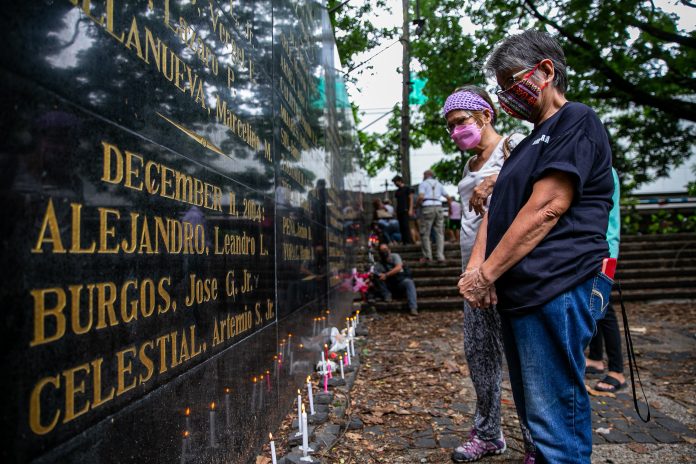This morning I woke up with fear in my heart.
Last night I fell asleep thinking of the text messages I have received. One said that the link to the Museum of the Malacańang Palace (the official residence of the President of the land) could no longer be accessed. This museum is home to important pieces of evidence about the martial law period in the Philippines.
Another message forwarded a news article which said the Ramon Cojuangco Building also known as the PLDT building was being petitioned by the Philippine Long Distance Telecommunications (PLDT) Co. to be removed as an important cultural property (ICP).
The National Commission for Culture and the Arts (NCCA) announced the petition on its official social media page on May 17. The Cojuangco clan to which Corazon Aquino and Benigno Aquino III (Philippine past presidents) belonged to is perceived-to-be adversaries of the Marcoses (Ferdinand Marcos Jr. is the presumptive president).
Of course, I have no idea yet about the circumstances surrounding these new messages. This morning, I deliberated should I delve deeper, spend precious time to verify and try to understand? What am I to do in the context of the “memories” I possess from the dark days of martial law?
Where is the fear coming from? Does it come from an almost certainty that parts of the past of our country is slowly being erased and replaced by untruths and, eventually, a false narrative of Philippine history will be fed to the present and next generations of Filipinos?
The fear was real. In fact, I dreamt of it last night and it stayed with me until I glanced at a framed quote on my wall that reads “Through a strange alienation, man in this world lives in the past, in his memories, or in expectation of the future, while he seeks to avoid the present moment, or exercises his spirit in inventing ways to kill time.” (P. Evdokimov)
I brought this to silence.
We are taught in formation that we have saints so that we can look to them to emulate them when discerning in our journey. They, who became holy through their humanity, teach us how to be human in our search for holiness. The archetype they embody in their lives serves as how “to live in the moment.”
For Mother Teresa of Calcutta, it was mercy. For St. Vincent de Paul, it was Jesus in the poor. For St. Ignatius of Loyola, it was “to the greater glory of God.” For Titus Brandsma, it was fidelity to truth in journalism. For St. Edith Stein, it was “the cross, our only hope.” For St. Francis of Assisi, it was poverty and ecology.
This is affirmed by St. Therese of Lisieux and St. Paul of the Cross. St. Therese, in her poem “My Song of Today,” says that life is but an instant that passes away, so she pleads for love, for trials, for sufferings, for guidance, for rest, for joy, for everything from the Lord, “only for today.” St. Paul of the Cross writes that the soul who rests in God without thought of the future but is preoccupied with living every event from moment to moment in His will is the happy soul.
Back to my fear. How am I to accomplish His will in the present moment? “Gaudium et Spes,” the Pastoral Constitution of the Church in the Modern World, assures us “In the depths of his conscience, man detects a law which he does not impose upon himself but which holds him to obedience,” (n.6) but “only in freedom can man direct himself toward goodness”(n.17) and “only by the aid of God’s grace can he bring such relationship with God to full flower.”
When our publication, the opposition We Forum (the pioneer publication during Martial Law) was just starting, we barely had enough funds to cover our daily operations. Thus we had a skeleton force which required us to multi-task.
I was general manager, janitor and sometimes messenger cum proofreader. If one typesetter was absent, I or my daughter had to fill in. Not being professional typesetters, of course, we learned as we worked, not without many mistakes. But my daughter, a 15-year-old student, just stuck to her typing, saying it was the right and the good thing to do.
Underneath the unclear shroud of duties we perform is the living of love at the moment. It is something like a visible sign of a conviction we hold on to. Even in the noisy, smoke-filled editorial room, a sanctuary existed where my girl related with her God.
Today, free and able, I find my sanctuary in the duties of ensuring that the memories I hold can be passed on to my children, grandchildren, and the world. The memories, that martial law was a cruel and dark period, that there was light from heroes both gone and living though from the distant and abstract past but when brought back to the present may provide the lessons from which hope for the future can be drawn.
Guided by Mother Teresa’s words “it is the love that we put into each deed that matters,” the present moment which entirely belongs to me we put in His hands which is Love itself. Let the evoking be a sacrament of love.
Edita Burgos is a doctor of education and a member of the Secular Order of Discalced Carmelites. Gunmen — believed to be soldiers — abducted her son Jonas Burgos in Manila in April 2007. He is still missing.









